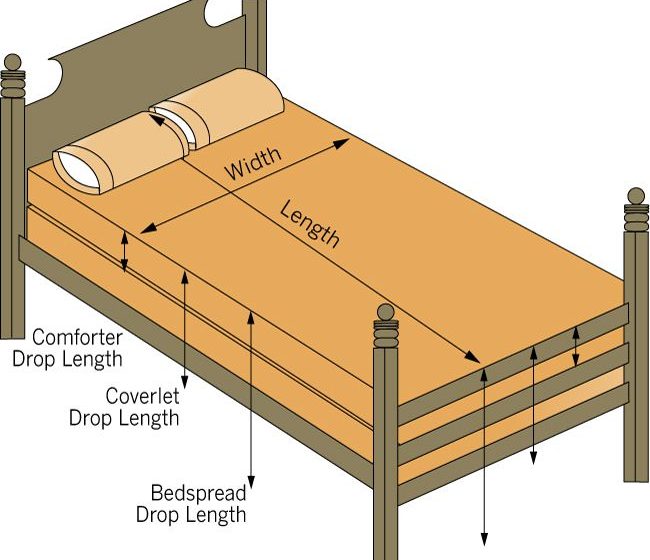Contents
Creating a quilt that fits your bed perfectly is a rewarding undertaking that can add a personal touch to your space, but it all starts with accurate measurements.
Whether you’re a seasoned quilter or a novice, understanding how to measure quilt size for various bed types is essential. A well-fitted quilt not only enhances the aesthetic appeal of your room but also ensures practicality and comfort during use.
In this article, we’ll guide you through the steps to take precise measurements for any bed size, ensuring your quilt is both functional and visually pleasing.
Getting the right quilt size isn’t just about the dimensions; it encompasses understanding how different styles, fabrics, and personal preferences can influence your final product. This comprehensive guide will provide you with the necessary knowledge to measure accurately and create a quilt that you’ll cherish for years.
Why Measuring Quilt Size Matters
Measuring quilt size accurately is crucial for several reasons. An improperly sized quilt can lead to discomfort, inefficiency in crafting, and wasted materials. Let’s explore the key reasons why knowing how to measure quilt size is essential.
Comfort and Functionality
The primary purpose of a quilt is to provide warmth and comfort. An ill-fitting quilt can lead to cold spots or insufficient coverage, which defeats its purpose. Measuring quilt size ensures that the quilt not only covers the entirety of the bed but also hangs down adequately to provide the desired warmth and aesthetic.
Avoiding Waste of Materials
Fabric can be expensive, and incorrect measurements can lead to significant waste. By taking accurate measurements, you ensure that you purchase the right amount of fabric needed for your quilt, saving money and time. This careful approach can prevent you from having to make multiple trips to the fabric store.
Enhancing Aesthetic Appeal
The visual impact of a quilt is greatly influenced by its size. A quilt that is too small may look out of place, while one that is excessively large can overwhelm a room’s decor. Properly measuring quilt size allows you to create a piece that complements your bedroom and matches your design vision perfectly.
Understanding Different Bed Sizes
Before you start measuring, it’s essential to understand the standard bed sizes, as quilts are typically made to fit these dimensions. Here are the common bed sizes you should know about:
Standard Mattress Sizes
- Twin: 38 inches x 75 inches
- Twin XL: 38 inches x 80 inches
- Full/Double: 54 inches x 75 inches
- Queen: 60 inches x 80 inches
- King: 76 inches x 80 inches
- California King: 72 inches x 84 inches
Knowing these dimensions provides a solid foundation for further measurements. However, it’s important to note that the thickness of the mattress should also be considered when measuring for your quilt.
Measuring Your Bed
To ensure your quilt fits perfectly, you’ll need to measure your bed accurately. Here’s how to do it:
- Gather Your Tools: You will need a measuring tape, a notepad, and a pen.
- Measure the Mattress Width: Measure the widest part of the mattress from side to side.
- Measure the Mattress Length: Measure from the head to the foot of the mattress.
- Account for Overhang: Decide how much overhang you want. Typically, 6-12 inches on each side provides ample coverage.
Always write down your measurements immediately to avoid confusion later.
Calculating Quilt Dimensions
Once you have your bed measurements, calculating the quilt dimensions requires a few additional steps. This process will ensure that your quilt is tailored perfectly for your bed.
Quilt Size Based on Bed Measurements
To calculate the size of your quilt, you can follow this simple formula:
- For Twin: (38 inches + 12 inches) x (75 inches + 12 inches) = 50 inches x 87 inches
- For Full: (54 inches + 12 inches) x (75 inches + 12 inches) = 66 inches x 87 inches
- For Queen: (60 inches + 12 inches) x (80 inches + 12 inches) = 72 inches x 92 inches
- For King: (76 inches + 12 inches) x (80 inches + 12 inches) = 88 inches x 92 inches
Note: The additional inches account for the desired drape over the sides.
Adjusting for Thickness and Style
If your mattress is particularly thick or if you are using a mattress topper, you may want to add extra height to your quilt measurements. Additionally, consider the quilt’s design; for instance, a tufted or heavily quilted design may shrink slightly, so it’s wise to account for that during your calculations.
Best Practices for Quilt Measurement
To ensure your quilt turns out as planned, follow these best practices while measuring and creating your quilt.
Check Your Measurements Twice
Always double-check your measurements before cutting fabric. One mistake can lead to wasted material and time. Make it a habit to measure twice and cut once.
Consider Pre-Washing Fabric
Fabrics can shrink after washing, so consider pre-washing your materials before cutting them to the final size. This will help you maintain the intended dimensions of your quilt. Consult the fabric care instructions to ensure proper washing methods.
Use a Quilting Calculator
For those who prefer digital assistance, consider using a quilting calculator available online. These calculators can assist in providing exact measurements, including adjustments for various styles and thicknesses. This tool can save you significant time and effort in the measurement and planning process.
Measuring quilt size for any bed type may seem daunting, but with these detailed steps and guidelines, you can tackle the task with confidence. By understanding the required dimensions, accounting for the mattress type, and taking the time to measure accurately, you will create a quilt that not only fits perfectly but also adds warmth and character to your bedroom.
Armed with this knowledge, you can now embark on your quilting project with the certainty that your quilt will be tailored beautifully to your bed, blending functionality with aesthetic appeal.

